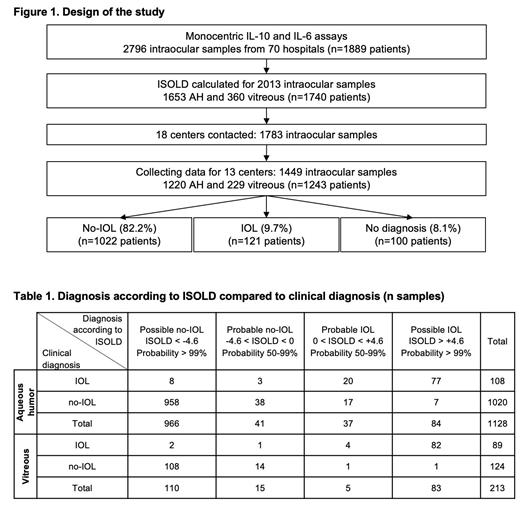Introduction
Primary vitreoretinal lymphoma (PVRL) is a rare and aggressive subset of large B-cell lymphoma of immune-privileged sites. It can occur independently or concomitantly to primary central nervous system lymphoma. Symptoms are not specific and can easily be confused with other uveitis. Diagnosis of intra-ocular lymphoma (IOL), including PVRL and secondary lymphoma localization, is based on malignant lymphoid cells identification in vitrectomy(cytology, flow cytometry, molecular analysis). Nevertheless, the fragility of lymphoma cells and low cellularity of samples make diagnosis difficult with these cellular tools. The quantification of interleukin (IL) in intraocular fluids is a promising soluble alternative approach. Based on IL-10 and IL-6 levels, an Interleukine Score for intra-Ocular Lymphoma Diagnosis (ISOLD) designed for aqueous humor (AH) and vitreous was published to guide the diagnosis of IOL (Costopoulos et al, Ophtalmology, 2016). The aim of this work was to evaluate ISOLD performances in real-life practice after five-year of use in a hospital laboratory.
Material and methods
IL-10 and IL-6 were measured in intra-ocular sample in a single laboratory using the cytometric bead array® kit (BD Biosciences TM) on a FACS Canto II cytometer, with a limit of quantification of 2.5 pg/ml. ISOLD is calculated at diagnosis in AH (AH-ISOLD) or vitreous (V-ISOLD) samples and is associated with a probability of having a large B-cell IOL. This score classifies patients according to two groups: i) reliable zone: ISOLD < -4.6 (<1% probability to have IOL) and ISOLD > +4.6 (>99% probability to have IOL) ; ii) doubtful zone: ISOLD ranging from -4.6 to +4.6 for which the probability and the clinical context have to be considered. All calculated ISOLD from January 2017 to December 2021 were collected. Centers with more than 30 intraocular samples with a calculated ISOLD were contacted to retrieve patients' definitive diagnosis and potential treatments.
Results
During these 5 years, IL-10 and IL-6 levels have been quantified for 2796 intraocular samples from 70 centers. ISOLD was calculated at diagnosis for 2013 ocular samples. Clinical data were obtained for 1449 samples (1220 AH and 229 vitreous) corresponding to 1243 patients from 13 out of the 18 centers contacted. 9.7% of patients had an IOL, 82.2% had another diagnosis than IOL and 8.1% of patients had no established diagnosis (Figure 1). Considering the 1341 samples with an established diagnosis, 92.7% were in the reliable zone and 7.3% were in the doubtful zone. For the 1128 AH samples, 1050 AH-ISOLD (93.1%) were in the reliable interpretation zone, with a concordant result for 98.6% of them (n=1035 samples) and a discordant result for 1.4% of them (n=15) (Table 1). The sensitivity and specificity were respectively estimated at 90.6% and 99.3% with a positive predictive value (PPV) of 91.7% and a negative predictive value (NPV) of 99.2%. Seventy-eight AH-ISOLD were in doubtful zone including 23 LIO and 55 others diagnoses than IOL. For the 213 vitreous samples, 193 V-ISOLD (90.6%) were in the reliable interpretation zone, with a concordant result for 98.4% of them (n=190 samples) and a discordant result for 1.6% of them (n=3) (Table 1). The sensitivity and specificity were estimated at 97.6% and 99.1%, respectively with a PPV of 98.8% and a NPV of 98.2%. Twenty V-ISOLD were in doubtful zone including 5 LIO and 15 others diagnoses than IOL. Three patients of the 8 who had a false-negative AH-ISOLD had a positive V-ISOLD. For the 17 AH-ISOLD in the doubtful zone, 4 of them had a V-ISOLD concordant with the diagnosis and 2 had an AH-ISOLD in the other eye concordant with the diagnosis. Independently of the sample type, the main cause of false-negative results was administration of corticosteroids prior to sampling and the main causes of false-positive results were infectious diseases (varicella and herpes virus, toxoplasmosis, syphilis).
Conclusion
This study confirmed on a 5-year period of real life practice that ISOLD, based on IL-10 and IL-6 levels, is a powerful tool to guide the diagnosis towards IOL. In more than 90% of intra-ocular samples, ISOLD was in reliable interpretation zone with very high sensitivity and specificity levels. In case of positive or doubtful AH-ISOLD, a vitrectomy is needed to make the diagnosis. Easy to use, not expansive, this score appears very useful to optimize the diagnostic approach of this rare and aggressive large B-cell lymphoma.
Disclosures
Ahle:Abbvie: Honoraria; Novartis: Honoraria; Roche: Honoraria; Sanofi: Honoraria; Pfizer: Honoraria. Le Garff-Tavernier:Alexion: Consultancy, Honoraria; Janssen: Honoraria; Novartis: Honoraria.


This feature is available to Subscribers Only
Sign In or Create an Account Close Modal